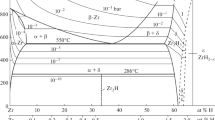Abstract
A new solid-state hydrogen reference electrode has been developed that is based on the two-component two-phase mixture of β-zirconium and δ-zirconium hydride, and is suitable for use in conjunction with the high-temperature proton-conducting CaZr0.9In0.1O3−δ solid electrolyte. Coulometric titration studies have confirmed the presence of a true two-phase plateau, existing over a wide composition range, which may be exploited as a precision thermodynamic buffer for reference hydrogen partial pressure. Cell voltage measurements have demonstrated that potentiometric hydrogen sensors incorporating this reference electrode exhibit Nernstian response over a broad range of temperature and hydrogen partial pressure, as well as excellent thermal cycling and long-term stability. The new solid-state hydrogen reference electrode is of considerable technological relevance and has already found application in a commercialised sensor unit.










Similar content being viewed by others
References
Iwahara H (1995) Solid State Ion 77:289
Iwahara H (1996) Solid State Ion 86–88:9
Kumar RV, Iwahara H (2000) In: Gschneidner KA Jr, Eyring L (eds) Handbook on the physics and chemistry of rare earths, vol 28, Chap. 178. Elsevier Science, Amsterdam
Iwahara H, Uchida H, Nagano T, Koide K (1989) Denki Kagaku 57:992
Yajima T, Koide K, Yamamoto K, Iwahara H (1990) Denki Kagaku 58:547
Yajima T, Iwahara H, Koide K, Yamamoto K (1991) Sens Actuators B 5:145
Zheng M, Zhen X (1993) Solid State Ion 59:167
Zheng M, Zhen X (1993) Metall Mater Trans B 24:789
Zheng M, Chen X (1994) Solid State Ion 70/71:595
Schwandt C, Fray DJ (2006) J Appl Electrochem 36:557
Yajima T, Kazeoka H, Yogo T, Iwahara H (1991) Solid State Ion 47:271
Iwahara H, Yajima T, Hibino T, Ozaki K, Suzuki H (1993) Solid State Ion 61:65
Kurita N, Fukatsu N, Kawahara T, Ohashi T (2002) J Electrochem Soc 149:D104
Mueller WM, Blackledge JP, Libowitz GG (1968) Metal hydrides, Chap. 8. Academic Press, New York
Näfe H (1990) J Nucl Mater 175:67
Kurita N, Fukatsu N, Ito K, Ohashi T (1995) J Electrochem Soc 142:1552
Hills MP, Schwandt C, Kumar RV (2006) J Electrochem Soc 153:H189
Schwandt C, Hills MP, Henson MA, Fray DJ, Henson RM, Moores A (2003) EPD Congress 2003. The Minerals, Metals and Materials Society, Warrendale, p 427
Hills MP, Thompson C, Henson MA, Moores A, Schwandt C, Kumar RV (2009) Light metals 2009. The Minerals, Metals and Materials Society, Warrendale, p 707
Hills MP, Henson MA, Thompson C, Geddes B, Schwandt C, Kumar RV, Fray DJ (2010) Light metals 2010. The Minerals, Metals and Materials Society, Warrendale, p 801
Acknowledgments
Financial support of this study by the Engineering and Physical Sciences Research Council (EPSRC) as well as Environmental Monitoring and Control Limited (EMC) is gratefully acknowledged.
Author information
Authors and Affiliations
Corresponding author
Rights and permissions
About this article
Cite this article
Hills, M.P., Schwandt, C. & Kumar, R.V. The zirconium/hydrogen system as the solid-state reference of a high-temperature proton conductor-based hydrogen sensor. J Appl Electrochem 41, 499–506 (2011). https://doi.org/10.1007/s10800-011-0260-9
Received:
Accepted:
Published:
Issue Date:
DOI: https://doi.org/10.1007/s10800-011-0260-9




